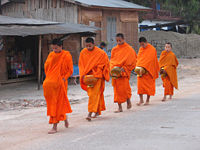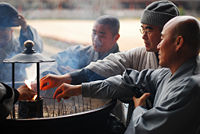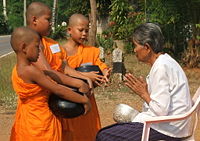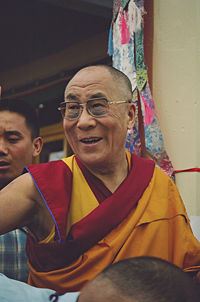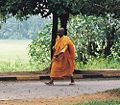Tipitaka - DO GOOD BE MINDFUL is the Essence of the Words of the Awakened One with Awareness
is the Voice of All Awakened Aboriginal Societies (VoAAAS) for welfare,
happiness and peace on the path of Eternal Bliss as Final Goal
— Attendance on awareness —
[ mahā+satipaṭṭhāna ]
from
Analytic Insight Net - Online Tipiṭaka Law Research & Practice University
in
112 CLASSICAL LANGUAGES
Online Tipiṭaka Law Research & Practice University
in
112 CLASSICAL LANGUAGES
Paṭisambhidā Jāla-Abaddha Paripanti Tipiṭaka nīti Anvesanā ca
http://sarvajan.ambedkar.org anto 112 Seṭṭhaganthāyatta Bhās
through
 http://sarvajan.ambedkar.org
http://sarvajan.ambedkar.org
Buddhasasana
Buddha Sasana
“In
the Buddha you see clearly a man, simple, devout, alone, battling for
light, a vivid human personality, not a myth. He too gave a message to
mankind universal in character.”
5A Main Road, 8th Cross HAL III Stage Bengaluru - 560075 Karnataka
India Ph: 91 (080) 25203792 Email: buddhasaid2us@gmail.com, http://sarvajan.ambedkar.org
17-05-2019
9:30 AM
BUDDHA JAYANTI DHAMMA DEEPA PROGRAM
At Nagavalli Village, Taluk Chamarajanagar, Dist. Chamarajanagar
Near City Market, Bengaluru -560002
Led by Ven. Bhikku Vimalarakkhita
Maha Bodhi Society 14, Kalidasa Road, Gandhinagar, Bengaluru - 560009, India
Led by Ven. Bhikku Dhammacitta
18-05-2019
Venue: Maha Bodhi Society 14, Kalidasa Road, Gandhinagar, Bengaluru - 560009, India
SACRED VESAKHA BUDDHA POORNIMA
9:00 AM
Siri Mahabodhi Puja, Vishwa Maitri Puja,
Siriada Cetiya Puja, Buddha Puja,
at Mahabodhi Lokashanti Buddha Vihara,
Undertaking of Tisarana, Attasila and Pancasila
administered by
Ven. Pamakkha Thera,
Sr. Teacher, Mahabodhi Monastic Institute
Dhamma Desana and Blessing by
Chief Guest
Ven. Dr. Varasambodhi Maha Thera
Vice President, Mahabodhi Society of India, Bodhgaya
Offering of redecorated Buddha Image by
Maha Upasika K.S. Bharati Bai Kamble, Hyderabad
Release of Publications
The Buddha and His Dhamma - Part 1, by Ven. Acharya Buddharakkhita
Positive Response, by Ven. Acharya Buddharakkhita
Guided Kannada & English Meditation Audio CD
Presided by
Venerable Kassapa Maha Thera
President Maha Bodhi Society, Bengaluru
11:00 AM
Sanghadana - Lunch offering for monks
12:30 PM
Lunch for devotees
1:30 PM
Dhamma Deeksha and Kannada Discourse by
Venerable Bhikkhu Ananda
General Secretary, Maha Bodhi Society, Bengaluru
3:00 PM
Upasampada - Higher Bhikkhu Ordination
and Documentary on Lord Buddha
4:30 PM
Tea Break
6:00 PM
Deepa Puja and Meditation under the Bodhi Tree and
Dhamma Desana, Offering Lights and
Vandana to Supremely Awakened Buddha
7:30 PM
Punanumodhana
Merit Sharing and conclusion with deepa puja
@ Kanchipuram, Tamil Nadu
09:30 AM
BUDDHA JAYANTI DHAMMA DEEPA PROGRAM
AtKanchi Mahabodhi Buddha Vihara,
Vaiyavoor Road, Near Old Railway Station, Kanchipuram, 631502
Led by Ven. Bhikku Dhammindo
Special Thanks to
Upasaka Nagasen, Dhoke, Upasaka Ambaresh, Upasaka Mali Patil,
& all other Upasakas & Upasikas
Kindly donate and earn merits, You may kindly send your donations to
Maha Bodhi Society
Account No. 353102010000137
IFSC Code: UBIN 0535311
MIRC Code: 560026005
Union Bank of India, Gandhinagar, Bangalore - 560009, India
We than all donors who have generously helped us
to make these programs successful
Maha Bodhi Society
14, Kalidasa Road, Gandhinagar, Bengaluru - 560009, India
Email: info@mahabodhi.info www.mahabodhi.info
Mobile: 9731635108, 9343158020, 9845703702
Thank you very much
All are Welcome
Bodhi Society, Bengaluru, is a Buddhist charitable Organization
established in 1956 by Venerable Acharya Buddharakkhita with the main
objective of reviving the compassionate teachings of the Buddha in the
land of its origin, India. Our aim is to put into practice the precious
teachings of the B…
TIPITAKA
|
Although the Buddha has left no Subhadda, a bhikkhu in the The Second Councilwas held The Third Council was held The Fourth Council was held The Fifth Council was The Sixth and the last Great Thanks to the efforts of those CONTENTS This voluminous Tipitaka is In Vinaya pitaka, In Sutta pitaka, or The third collection, The most wonderful thing about all The size of the Tipitaka Texts do |
VINAYA PITAKA
|
|
SUTTA PITAKA
|
|
ABHIDHAMMA PITAKA
|
|
| History | |||
|
Classification: (1) Vinaya, (2) |
|||
|
‘A Guide to Tipitaka’ Professor U Ko Lay |
|||
https://www.nalanda.org.my/introducing-the-pali-tipitaka/
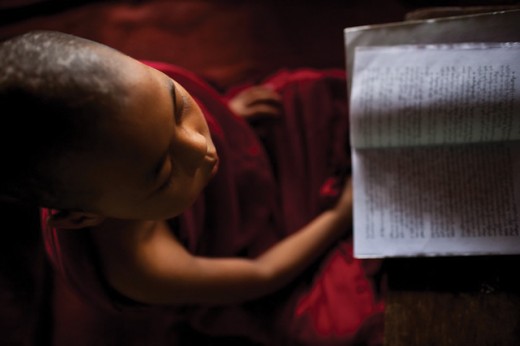
The Pāli Language was derived from a Prakrit
(folks’ dialect) of Magādha in ancient India ( All spices in the world have their own Prakrit
(natural) languge to communicate.Sinillarly if a new born baby is
separated and kept in isolation without any communication, it will speak
a natural language just like other spcies. That language is Magādha (Prakrit
) the natural language of Human Beings. All other languages emerged
from Magadha which was the mother tounge of Buddha. Its grammar is
similar to
those of Sanskrit and Latin. Pāli was chosen as the language to
rehearse and record the Buddhist teachings at the First Rehearsal (Sangāyana)
in 543 BCE. Pāli is unique among languages in that it is not used for
any other purpose except to record Buddhist doctrines. Thus the meanings
of its words were not ‘corrupted’ by common usage or ‘evolution’ over
time.
The Three Major Divisions of Pāli Tipitaka
Vinayapitaka
The Vinayapitaka is a collection of monastic rules, their origin,
issues regarding the administration of the monastic order, training
rules outside the Patimokkha, and rules concerning the use of
requisites. It also records the history of the Sangha’s formation, and
the events leading to the first and second rehearsals of the Pāli Canon.
This Pitaka is divided into five books – the Mahāvibhanga, Cullavibhanga, Mahāvagga, Cullavagga and Parivāra Pāli.

Novice monks are taught the Dhamma and Vinaya for many
years before being allowed to undergo their “Higher Ordination” as
full-fledged bhikkhus.
Suttapitaka
The Suttapitaka is a large collection of discourses, sermons and
sayings of the Buddha, and some of His foremost disciples, delivered on
various occasions to individuals and groups. It is divided into five
major collections (Nikāya) – the Dīghanikāya, Majjhimanikāya, Samyuttanikāya, Anguttaranikāya, and Khuddakanikāya –
which in turn are further divided into many books and sections. These
discourses touch on mundane topics to the supramundane, as they were
delivered to beginners as well as to adept Arahant disciples.
Informative narrations and prose can be found in many longer texts,
while shorter ones, such as the Dhammapada, Udāna, Theragātha and Therigātha, contain some of the most poetic literature in verse.
Abhidhammapitaka
The Abhidhammapitaka contains seven treatises – the Dhammasanganī, Vibhanga, Dhātukathā, Puggalapaññatti, Kathāvatthu, Yamaka, and Patthāna.
These treatises deal with Dhamma subjects in purely academic terms,
without referring to any individuals or providing narrations of events
as found in the Suttapitaka. Important doctrinal points, such as
consciousness, the mind, wholesome and unwholesome qualities, meditative
absorption, the nature of elements, stages of purification and
enlightenment, are all detailed in this massive collection.

Bhikkhus and novice monks often recite passages from the Abhidhamma in communal chantings.
Commentarial Tradition
Over the centuries, learned scholar-monks have composed commentaries to aid the learning of the Tipitaka. These are called Atthakathā in Pāli Language. Although they are not regarded as canonical, the Atthakathās are
nevertheless indispensable in better understanding certain parts of the
Canon. The most famous commentators were two 4th to 5th Century CE
monks – the Elders Buddhaghosa and Dhammapala – both of whom authored
the greater part of Pāli commentaries.
Additions to the Canon
The present structure of the Pāli Canon is largely the compilation of the Third Rehearsal of Dhamma-vinaya during Mauryan Emperor Asoka’s reign in the 3rd Century BCE. The Abhidhammapitaka was formally recited and incorporated into the Canon (thus making it “Ti-pitaka” – 3 divisions) during this rehearsal.
In the 1871CE Fifth Rehearsal in Mandalay, three ancient and highly venerated Pāli works – the Nettippakarana, Petakopadesa and Milindapañhā – were added to the Canon and placed under the Khuddakanikāya division of the Suttapitaka. These last three additions appeared in printed form as part of the Pāli Canon after the Sixth International Rehearsal in 1956.
The entire Pāli Tipitaka is nowadays commonly produced in a 40 to 45
volume (book) collection. For example, the Thai Pāli Tipitaka usually
contains 45 printed volumes, symbolically representing the 45 years of
Buddha’s mission.
Pāli Tipitaka
The Pāli Tipitaka comprises 31 books of various sizes. Certain
treatises of the Tipitaka are so large that they are spread over several
volumes. Together with their equally voluminous commentaries, the
Tipitaka offers a thorough exposition of Buddhist teachings covering all
aspects of practice from the mundane to the supramundane. Below is a
list of the 31 books in their original Pāli names and brief descriptions
of their contents, as well as their respective commentarial texts.
Note: Three later additions to the Pāli Canon (the
Nettippakarana, Petakopadesa and Milindapañhā classified under the
Khuddakanikāya) are not listed below. Their inclusion will result in the Canon having 34 books (and the Suttapitaka having 18 books).
| Pāli Tipitaka Canonical Books |
General description & Major contents | Commentaries (Atthakathā) |
|
| 1. | Vinayapitaka |
Collection of monastic rules, their origin, and historical
events relating to the Sangha’s formation. Divided into 5 collections. |
The entire collection in the Vinayapitaka shares a single commentary.
|
| 1.1 | Mahāvibhanga | Major rules for bhikkhus (monks). | Samantapāsādikā |
| 1.2 | Cullavibhanga | Major rules for bhikkhunis (nuns). | Samantapāsādikā |
| 1.3 | Mahāvagga |
Rules of admission to the Bhikkhu Sangha; concerning the monks’ way of life, and the administration of the monastic order.
|
Samantapāsādikā |
| 1.4 | Cullavagga |
Training rules regarding the use of requisites; origin of the
Bhikkhunī Sangha; historical records of the first and second rehearsals. |
Samantapāsādikā |
| 1.5 | Parivāra | Catechism on the knowledge of Discipline. | Samantapāsādikā |
| 2. | Suttapitaka |
Collection of discourses, sermons and sayings of the Buddha and
some of His foremost disciples. Divided into 5 major collections and many subdivisions according to subjects and the length of the discourses. |
The first 4 Nikāyas have their own commentaries. The Khuddakanikāya has 8 commentarial texts.
|
| 2.1 | Dīghanikāya | Collection of 34 long discourses, divided into 3 sections. | Sumangalavilāsinī |
| 2.2 | Majjhimanikāya | Collection of 152 medium-length discourses divided into 3 sections. | Papañcasūdanī |
| 2.3 | Samyuttanikāya |
Collection of more than two thousand discourses specially
arranged in 5 major divisions and further subdivided into 56 groupings (Samyutta) according to their subject matters. |
Sāratthapakāsinī |
| 2.4 | Anguttaranikāya |
Collection of more than nine thousand discourses divided into 11 major numerical divisions (from Number One to Number Eleven).
|
Manorathapūranī |
| 2.5 | Khuddakanikāya |
Collection of discourses and sayings other than those classified
under the earlier 4 Nikāyas. There are 15 books under this Nikāya. (Note : 18 books if the three later additions were included.)
|
The 15 books in the Khuddaka-nikāya share 8 commentarial
texts between them.
|
| 2.5.1 | Khuddakapātha |
Collection of short discourses and text commonly used in chanting and blessings.
|
Paramatthajotikā |
| 2.5.2 | Dhammapada | Collection of 423 concise and inspiring verses of Dhamma in 26 chapters. | Dhammapadātthakathā |
| 2.5.3 | Udāna |
Collection of 80 discourses containing the Buddha’s solemn utterances – the “Paeans of Joy”.
|
Paramatthadīpanī |
| 2.5.4 | Itivuttaka | Collection of 112 discourses, all beginning with “Iti vuccati…” | Paramatthadīpanī |
| 2.5.5 | Suttanipāta |
Special “collected discourses” of 71 sermons composed entirely or mostly in verses.
|
Paramatthajotikā |
| 2.5.6 | Vimānavatthu |
“Stories of celestial splendour” – 85 narrations by celestial beings on the effects of their past lives’ good deeds.
|
Paramatthadīpanī |
| 2.5.7 | Petavatthu |
“Stories of deprived beings” – 51 remorseful narrations by spirits on the effects of their past lives’ evil deeds.
|
Paramatthadīpanī |
| 2.5.8 | Theragātha |
Collection of verses uttered by 264 Arahant bhikkhus on their lofty spiritual attainments.
|
Paramatthadīpanī |
| 2.5.9 | Therīgātha | Collection of verses uttered by 73 Arahant bhikkhunis as above. | Paramatthadīpanī |
| 2.5.10 | Jātaka |
Collection of 547 tales about the past lives of the Buddha before His final birth.
|
Jātakātthakathā |
| 2.5.11 | Niddesa |
“Exposition” – collection of the Elder Sariputta’s explanation of the Dhamma based on the Buddha’s preaching in the Suttanipāta.
|
Saddhammapajjotikā |
| 2.5.12 | Patisambidāmagga |
“Way of Analysis” – collection of Elder Sariputta’s
detailed explanation of topics such as insight, mindfulness, views, spiritual faculties and deliverance. |
Saddhammapakāsinī |
| 2.5.13 | Apadāna |
Collection of nearly 600 accounts concerning the past lives of Buddhas, Pacceka-Buddhas, Arahant bhikkhus and bhikkhunis.
|
Visuddhajanavilāsinī |
| 2.5.14 | Buddhavamsa |
Collection of stories concerning the previous 24 Buddhas, and concluding with the story of Buddha Gotama.
|
Madhuratthavilāsinī |
| 2.5.15 | Cariyāpitaka |
Collection of 35 stories of Buddha’s past lives (as told in the
Jātaka), with special emphasis on His mode of conduct in fulfilling the ten compulsory perfections of Buddhahood. |
Paramatthadīpanī |
| 3. | Abhidhammapitaka |
Collection of academic and philosophical terms of the teachings. Divided into seven treatises.
|
The first 2 treatises have their own commentaries. The latter 5 share a common one.
|
| 3.1 | Dhammasanganī | Collection of teachings – 164 matrices and summaries of all phenomena. | Atthasālinī |
| 3.2 | Vibhanga |
Collection of 18 sections dealing with 18 important subjects in the
Teachings, such as the Four Noble Truths, the Factors of Enlightenment, and Dependent Origination. |
Sammohavinodanī |
| 3.3 | Dhātukathā | Discussions on Elements – the five aggregates, twelve sense-fields, etc. | Pañcapakaranātthakathā |
| 3.4 | Puggalapaññatti | On Individuals – designation of individuals according to their virtues. | Pañcapakaranātthakathā |
| 3.5 | Kathāvatthu |
Collection of 219 subjects in question and answer format, refuting
false views held by heretics. This treatise was compiled by Moggalliputta-Tissa Thera, and added to the Canon in the Third Rehearsal, held in the 3rd Century BCE. |
Pañcapakaranātthakathā |
| 3.6 | Yamaka | Collection of questions and answers to important topics in 10 pairings. | Pañcapakaranātthakathā |
| 3.7 | Patthāna |
Large collection of explanations to the conditionality, interdependence, and causality of phenomena.
|
Pañcapakaranātthakathā |
A Bhikkhu (Pāli), or Bhiksu (Sanskrit), is a fully ordained male Buddhist monastic. Female monastics are called Bhikkhunis. The holy orders in Buddhism connect back to the central roots of Buddhism, the original followers of Buddha. When Prince Siddhartha
chose to follow the ascetic path to find the truth, giving up his
worldly position, and became Buddha, he set up a community of monks,
Bikkhu sangha Sanskritt, Bhiksu, and nuns, Bikkhuni sangha, to help with the work of teaching the Dharma (Buddhist teachings). Bhiksu may be literally translated as “beggar” or more broadly as “one who lives by alms.”
Bhikkhus and Bhikkhunis keep many precepts: They live by the vinaya’s
framework of monastic discipline, the basic rules of which are called
the patimokkha. The original rules and regulations of the monastic
orders, called the patimokkha, were set out by the Buddha himself, then
adapted over time to keep step with changes in the world. Their
lifestyle is shaped so as to support their spiritual practice, to live a
simple and meditative life, and attain Nirvana, the goal of all Buddhists.
Contents[hide] |
In addition to pursuing their own spiritual advancement, Bhikkhu and
Bhikkuni also stand in a position of leadership to the Buddhist
community among which they live. Other members of the spiritual
community look to them as an example, for guidance, and for
understanding. This is one of the reasons that strict training and
discipline are required in the process of becoming a monk or nun in the
Buddhist or any other faith. It is important for those in positions of
leadership to maintain a high standard of faith and set a good example
in their words and actions.
Introduction
Bhikkhu may be literally translated as “beggar” or more broadly as “one who lives by alms.”
One of the most complete collection of teachings about the proper
course for Buddhist monks and nuns can be found in the Pāli Canon, a
collection of scriptures
in the Theravada Buddhist tradition. Scholars do not agree about
whether this information came directly from Buddha himself, or was
formulated by early followers, based on Buddha’s teachings. The Pāli
Canon describes a Bhikkhu as “the person who sees danger (in samsara or
cycle of rebirth).” He, therefore, seeks ordination as a monk in order
to release from it. One passage from the Dhammapada section of the canon
states:
Not therefore is he a bhikkhu
Merely because he begs from others.
Not by adopting the outward form
Does one truly become a bhikkhu.
He who wholly subdues evil,
Both small and great,
Is called a monk (bhikkhu)
Because he has overcome all evil (Dhp 266, 267).
A bhikkhu has taken a vow to enter the Sangha (Buddhist monastic
community) and is expected to obey rules of conduct (typically around
227 for a male) as set out in the Vinaya, although there are
considerable local variations in the interpretations of these rules. A
novice monk or nun in the Tibetan
tradition takes 36 vows of conduct. The minimum age to take bhikkhu
vows is 21 years (although this also varies from country to country).
The establishment of a monastic community meant that the greater
community of Buddhist faithful could be described in four groups: Male
and female lay believers, and Bikku (Bhikkhu in pali and Bhikshu in Sanskrit),
and Bikkhuni (Bhikkuni in Pali and Bhikshuni in Sanskrit), the male and
female ordained monks. Joining the ranks of the ordained is the highest
goal of Buddhist practitioners. The monks and nuns are the pillars of
the community of faith, spreading Buddhist teachings and serving as
living examples for the lay believers to follow. Also, by serving as a field of merit,
they give laymen the opportunity to gain merit by supporting the
ordained community with donations of food and money. The disciplined
life in the monastic order also contributes towards the monks’ and nuns’
pursuit of the liberation of Nirvana through the cycle of rebirth.
Monks and nuns
In English literature prior to the mid-twentieth century, Buddhist monks were often referred to by the term bonze,
particularly when describing monks from East Asia and French Indochina.
This term is derived via Portuguese and French from the Japanese word bonsō for a priest or monk, and has become less common in modern literature.[1]
Although the European terms “monk” and “nun” are applied also on
Buddhism, the situation of “ordination” in Buddhism is more complicated,
involving several levels of commitment.
In Buddhism, monkhood is part of the system of “vows of individual
liberation.” These vows are taken by monks and nuns from the ordinary
sangha, in order to develop personal ethical discipline. In Mahayana
Buddhism, the term “sangha” is, in principle, restricted to those who
have achieved certain levels of understanding. They are, therefore,
called “community of the excellent ones” (Tib.
such vows).
Monks usually traveled in small groups, living at the outskirts of
the village. The monks depended on donations of food and clothing from
the residents of the village. Part of Buddha’s direction was that the
members of the monastic order gather in larger groups and live together
during the rainy season. The dwellings where they stayed during these
times were also to be given voluntarily by people from the community.
Over time, the dwellings became more permanent, the monks settled in
regions; their lifestyle became less nomadic, and the monks started to live communally in monasteries. The patimokka, rules governing life in the monastery, were developed, prescribing in great detail the way to live and relate in a community. For example, the patimokka in the Theravada branch of Buddhism contains 227 rules.
Joining the order
The vows of individual liberation are taken in four steps. A lay
person may take the five vows called “approaching virtue” (in Tibetan genyen
that, one can become a novice or samanera (Skt. shramanera, Tib. getshül
Tib. (
term. The translation from Sanskrit is bikshuni (female) or bikshu
(male). The Pali term is bhikkhuni (female) or bhikkhu (male), used in
Theravada Buddhism (Sri Lanka, Burma, Thailand).
Laymen who wish to join the order must approach a monk who has been
in the order for at least ten years, and ask to be taken in. First
ordained as a samanera (novice), they have their heads shaved,
and begin to wear the robes appropriate to the order they have joined.
For a period of at least a year, they must live by the Ten
Precepts—refraining from sexual contact, refraining from harming or
taking life, refraining from taking what is not given, refraining from
false speech, refraining from the use of intoxicants, refraining from
taking food after midday, refraining from singing, dancing, and other
kind of entertainment, refraining from the use of perfume, garland and
other adornments, refraining from using luxurious seats and refraining
from accepting and holding money. They are not required to live by the
full set of monastic rules. Boys from eight years old can be ordained as
samanera. Women are usually first ordained when adults. From the age of
20, samanera can be ordained to the full level of Bikkhu or Bikkhuni.
The Buddha instructed that in order to be ordained as Bikkhu or
Bikkhuni, the applicant need to have a preceptor. The preceptor is
usually the elderly monk that ordained the applicant as samanera. The
samanera needs to approach a community of at least ten monks of at least
ten years standing each and who are well respected for their virtues
and learning. The monks would then ask the applicant eleven questions to
assess his readiness, suitability and motives: (1) Are you free from disease? (2) Are you a human being?
(3) Are you a man? (4) Are you a free man? (5) Are you free from debt?
(6) Do you have any obligations to the king? (7) Do you have your parents‘
permission? (8) Are you at least twenty years of age? (9) Do you have
your bowl and robe? (10) What is your name? (11) What is your teacher’s
name? If the applicant answers satisfactorily to these questions, he/she
will request ordination three times and if there is no objection from
the assembly, he/she is considered a monk/nun.
Monks and nuns take their vows for a lifetime, but they can “give
them back” (up to three times in one life), a possibility which is
actually used by many people. In this way, Buddhism keeps the vows
“clean.” It is possible to keep them or to leave this lifestyle, but it
is considered extremely negative to break these vows.
In Tibet, usually small children from 6 onwards can take the rabjung ordination which is a child-specific approach to monastic life. At age 14, they usually take getshül ordination which includes more rules, and after age 21, many take the gelong ordination—or prefer to quit the monastic life.
Hierarchy among monks
In most branches of Buddhism, there are no formal rules that define a
hierarchy within the monastery. However, tacit rules of obedience to
the most senior member of the Sangha, and other rules stemming from the
teacher/student, senior/junior and preceptor/trainee relationship are at
work within the monastery. Decisions to be taken concerning life in the
monastery are usually done in communal meetings.
The daily running of the monastery is in the hand of an abbess or abbot
who may appoint assistants. The position of abbess / abbot are usually
held by one among the senior members of the monastery. In some case
he/she will be elected by the members of the order, and in other cases
the lay community will choose him/her.
Women were not originally included in the ascetic community by the
Buddha. However, after incessant pressures from his aunt and stepmother,
Maha Pajapati Gotami, he accepted the ordination of women. Stronger
restrictions and rules were put on the communities of nuns, however,
such as the precedence of monks over the nuns in matter of respect and
deference, the prohibition of nun teaching monks, and that the
confession and punishment of nuns should be done before a joint assembly
of both nuns and monks.
Robes
The special dress of ordained Buddhist monks and nuns, the robes,
comes from the idea of wearing cheap clothes just to protect the body
from weather and climate. They shall not be made from one piece of
cloth, but mended together from several pieces. Since dark red was the
cheapest colour in Kashmir, the Tibetan
tradition has red robes. In the south, yellow played the same role,
though the color of saffron also had cultural associations in India; in East Asia, robes are yellow, grey or black.
In Tibet, there are pronounced differences in the robes of monks at
various stages of their vocation. One difference is that rhe robes of
getshül novices do not include the “holes” that can be found in the
robes of gelong monks. Some monks tear their robes into pieces and then
mend these pieces together again. The younger rabjung novices do not
wear the “chö-göö,” or yellow tissue worn during Buddhist teachings by
both getshüls and gelongs.
Adherants of Buddhism in many countries have traditions of special
robes as part of the observance of the Kathina festival, which
traditional comes at the end of the rainy season. To celebrate Kathina, a
special Kathina robe is made in 24 hours from donations by lay
supporters of a temple. The robe is donated to the temple or monastery,
and the resident monks then select from their own number a monk to
receive this special robe. The monk is selected from those who have
observed a special three month period of retreat and meditation during
the rainy season. [2]
Marriage and celibacy
Celibacy
was a requirement for the members of the Buddhist orders, as
established by Buddha. Even up until today, in some branch of Buddhism
this rule is still in effect. However, as the Buddha was a pragmatic
teacher and the rules he set for the monastic life prone to change, he
predicted, as women were ordained that the rule of celibacy will not
hold for more than 500 years. In fact, since the seventh century in India, some groups of monks were getting married. In Japan, from the Heian period (794-1105 C.E.),
cases of monks getting married started to appear. However it was during
the Meiji restoration, from the 1860’s that marriage by monks was
officially encouraged by the government. Since that time, Japan remains
the country with the largest number married monks among the higher orders. Marriage by monks is also practiced in other country, including Korea and Tibet.
Tantric vows
A lay person (or a monk/nun) engaging in high tantric practices and
achieving a certain level of realization will be called a yogi (female
“yogini,” in Tibetan naljorpa/naljorma
yogis (monks or lay) observe another set of vows, the tantric vows
(together with the bodhisattva
vows); therefore, a yogi/yogini may also dress in a special way, so
that they are sometimes called the “white sangha” (due to their often
white or red/white clothes). Both ways, tantric and monastic are not
mutually exclusive; although they emphasize different areas of Buddhist
practice, both are ascetic.
Other vows
There are still other methods of taking vows in Buddhism. Most
importantly, “Bodhisattva vows” are to be taken by all followers of
Mahayana Buddhism; these vows develop an altruistic attitude. Another
“centering of self” method is taking strict one-day vows which are
somewhat similar to monk’s/nun’s vows (”Mahayana precepts”), but last
only from one sunrise to another sunrise.
Conclusion
Ordination in Buddhism is a cluster of methods of self-discipline
according to the needs, possibilities and capabilities of individuals.
According to the spiritual development of his followers, the Buddha gave
different levels of vows. The most advanced method is the state of a
bikkhu(ni), a fully ordained follower of the Buddha’s teachings. The
goal of the bhikku(ni) in all traditions is to achieve liberation from
suffering.
Beside that, the Mahayanist approach requires bodhisattva vows, and
the tantric method requires tantric vows. Since some people are not
attracted to monk/nun ordination, all other vows can be taken
separately. On the other hand, it is said that one cannot achieve the
goal without taking the vows of individual liberation—that is, comply
with the ethical disciple inscribed in these vows.
Gallery
|
May 11, 2019, 6:26 PM (21 hours ago)
|
| Dear Reader,Your comment is now displayed on economictimes.com. Please click here to view it on the website. And do keep writing in. Thank you, Rgds, Editor |
|
|||
Founder
president of the Muslim Gau Raksha Sangh, Irfan Sheikh, said the idea
to form the organisation was seeded by Athawale himself who had viewed
that Muslims should also come forward to protect the cow, revered by the
Hindus.
Voice of All Awakened Aboriginal Societies (VoAAAS)
Just
0.1% intolerant, violent, militant, number one terrorists of the
worlds, ever shooting, mob lynching, lunatic, mentally retarded,
Paradesis from Bene Israel chitpavan brahmins of RSS (Rowdy Rakshasa
Swayam Sevaks) and all their stooges, chamchas, chelas, slaves,
bootlickers and own mother’s flesh eaters full of hatred, anger,
jealousy, delusion, stupidity, which are defilement of the mind working
against 99.9% all aboriginal awakened societies must be treated in
mental asylums in Bene Israel and make them quit Prabuddha Bharat.


